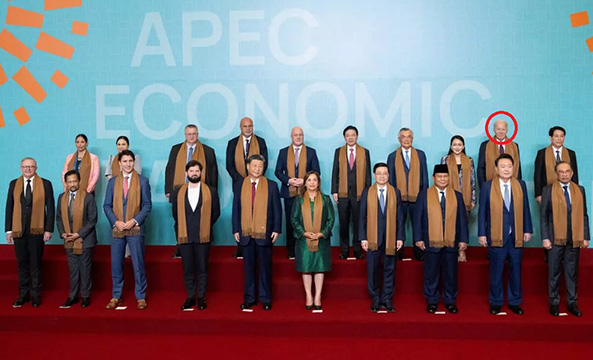 Xi in the front place, while Biden became a backbencher at the Asia-Pacific summit in the Peruvian capital Lima.
Xi in the front place, while Biden became a backbencher at the Asia-Pacific summit in the Peruvian capital Lima.
Photo: AP
Peru gave Xi Jinping a warm welcome last week when he arrived for the Asia-Pacific Economic Cooperation summit in Lima. The Chinese leader was even accorded the honor of a state visit.
Joe Biden, in contrast, got a bare-bones greeting as Air Force One landed, ‘Newsweek’ stresses.
Peru then proceeded to treat the American President as if he were from a backwater state, even making sure the humiliation was seen in public. For instance, in the group photo of leaders attending the summit, Xi was standing in the place of honor, to the right of Peruvian President Dina Boluarte in the front row. Biden was placed in the back in the corner.
America, in what Americans sometimes call their "backyard," is being disrespected. China, on the other hand, looks ascendant, trading and investing its way into dominance of the region.
Perhaps we shouldn't be surprised: China is Peru's and South America's largest trading partner. Beijing emphasizes "South-South cooperation," explicitly including itself in its now-favorite term, the "Global South."
This "cooperation" in practice means China largely buys food from the region, such as soybeans, as well as raw materials like copper and petroleum. In return, China exports manufactured products, undermining local industries in South America. Some call this type of relationship "neo-colonialism."
"As with sub-Saharan Africa, Beijing will keep South America stuck with selling it raw materials and buying Chinese products in return," trade expert Alan Tonelson told me. "China's refusal to buy local manufactures will help leave the region mired in poverty. Only Mexico is likely to escape this fate, thanks to its USMCA trade agreement with the United States and Canada."
China's investment in South America will also bolster its trade dominance. China's Belt and Road Initiative, stalled in many other places, is set to transform the region. As China state broadcaster CGTN reports, "From Chancay to Shanghai" has become "a simple phrase that's bridging continents."
China's $1.3 billion Chancay Port held its grand opening. Xi Jinping participated in the ceremony by video link with President Boluarte.
"Chancay is intended to be the core of a new hub-and-spoke logistics system, controlled by the Chinese giant COSCO, positioning it to capture the value added of trans-Pacific logistics while also supporting Chinese companies seeking to dominate access to commodities and markets across Latin America," R. Evan Ellis of the Army War College noted in an e-mail message to me.
The port is so significant that it could change trade flows across the Pacific and throughout South and Central America. "Critically, COSCO's exclusive control over the port, conferred to it by accident or negligence by Peru's port authority APN, then ratified by the Boluarte government changing its own laws to avoid a fight with the Chinese, positions COSCO to not only control the trans-Pacific route but to control the feeder routes into Chancay," pointed out Ellis.
"The massive port-building could end up giving Beijing's navy extensive access to the Western Hemisphere, creating a major challenge to the Monroe Doctrine and the most dangerous regional threat to U.S. national security since the Cuban Missile Crisis of October 1962," states Tonelson, who blogs on trade and geopolitical matters at RealityChek.
As Ellis points out, COSCO's total control of the Chancay port increases the possibility that Chinese warships could use the facility either in a time of conflict with the U.S. or in peacetime, to support other military operations to threaten American and allied targets in the Eastern Pacific.
read more in our Telegram-channel https://t.me/The_International_Affairs

 9:58 23.11.2024 •
9:58 23.11.2024 •






















